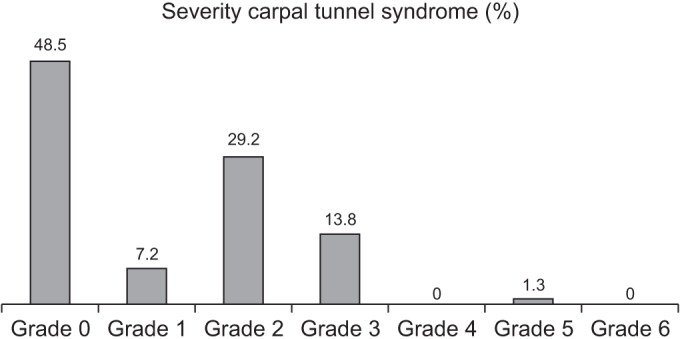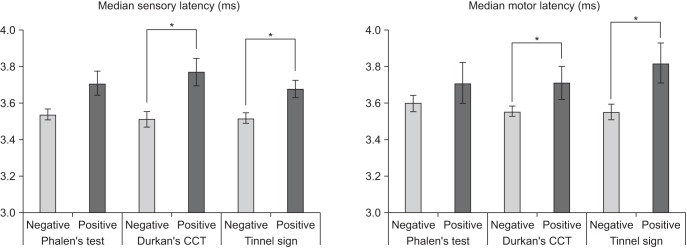Ann Rehabil Med.
2016 Oct;40(5):902-914. 10.5535/arm.2016.40.5.902.
Prevalence and Related Characteristics of Carpal Tunnel Syndrome Among Orchardists in the Gyeongsangnam-do Region
- Affiliations
-
- 1Department of Rehabilitation Medicine, Gyeongsang National University Hospital, Jinju, Korea. yoonch@gnu.ac.kr
- KMID: 2382923
- DOI: http://doi.org/10.5535/arm.2016.40.5.902
Abstract
OBJECTIVE
To determine the prevalence and related characteristics of carpal tunnel syndrome (CTS) in orchardists and to investigate the association between electrodiagnostic severity and physical examinations.
METHODS
Between July 2013 and September 2014, 377 subjects (174 men and 203 women) visited the Gyeongsang National University Hospital's Center for Farmer's Safety and Health. All the subjects underwent electrodiagnostic tests and physical examination, including Phalen's test, Tinel's sign, and Durkan's carpal compression test (CCT). The subjects were classified into 2 groups, the normal group and the CTS group, according to electrodiagnostic test results. To determine the related characteristics of CTS, potential variables, including age, sex, drinking, smoking, body mass index, waist circumference, and total work time, were compared between the 2 groups. The association between electrodiagnostic severity and physical examinations was analyzed.
RESULTS
CTS was diagnosed in 194 subjects based only on electrodiagnostic test results, corresponding to a prevalence of 51.5%. Among the variables, mean age (p=0.001) and total work time (p=0.007) were significantly correlated with CTS. With respect to the physical examinations, low specificities were observed for Tinel's sign, Phalen's test, and Durkan's CCT (38.4%, 36.1%, and 40.9%, respectively) in the subjects aged ≥65 years. In addition, Phalen's test (p=0.003) and Tinel's sign (p=0.032) in men and Durkan's CCT (p=0.047) in women showed statistically significant differences with increasing CTS severity. The odds ratio was 2.066 for Durkan's CCT in women according to the multivariate logistic regression analysis.
CONCLUSION
CTS prevalence among orchardists was high, and Durkan's CCT result was significantly quantitatively correlated with the electrodiagnostic test results. Therefore, Durkan's CCT is another reliable examination method for CTS.
MeSH Terms
Figure
Reference
-
1. Dale AM, Descatha A, Coomes J, Franzblau A, Evanoff B. Physical examination has a low yield in screening for carpal tunnel syndrome. Am J Ind Med. 2011; 54:1–9. PMID: 21154516.
Article2. de Krom MC, Knipschild PG, Kester AD, Thijs CT, Boekkooi PF, Spaans F. Carpal tunnel syndrome: prevalence in the general population. J Clin Epidemiol. 1992; 45:373–376. PMID: 1569433.
Article3. Herbert R, Gerr F, Dropkin J. Clinical evaluation and management of work-related carpal tunnel syndrome. Am J Ind Med. 2000; 37:62–74. PMID: 10573597.
Article4. Aroori S, Spence RA. Carpal tunnel syndrome. Ulster Med J. 2008; 77:6–17. PMID: 18269111.5. Barr AE, Barbe MF, Clark BD. Work-related musculoskeletal disorders of the hand and wrist: epidemiology, pathophysiology, and sensorimotor changes. J Orthop Sports Phys Ther. 2004; 34:610–627. PMID: 15552707.
Article6. Bonfiglioli R, Mattioli S, Armstrong TJ, Graziosi F, Marinelli F, Farioli A, et al. Validation of the ACGIH TLV for hand activity level in the OCTOPUS cohort: a two-year longitudinal study of carpal tunnel syndrome. Scand J Work Environ Health. 2013; 39:155–163. PMID: 22752342.
Article7. Leclerc A, Franchi P, Cristofari MF, Delemotte B, Mereau P, Teyssier-Cotte C, et al. Carpal tunnel syndrome and work organisation in repetitive work: a cross sectional study in France. Study Group on Repetitive Work. Occup Environ Med. 1998; 55:180–187. PMID: 9624269.
Article8. Armstrong T, Dale AM, Franzblau A, Evanoff BA. Risk factors for carpal tunnel syndrome and median neuropathy in a working population. J Occup Environ Med. 2008; 50:1355–1364. PMID: 19092490.
Article9. Atroshi I, Gummesson C, Johnsson R, Ornstein E, Ranstam J, Rosen I. Prevalence of carpal tunnel syndrome in a general population. JAMA. 1999; 282:153–158. PMID: 10411196.
Article10. Roquelaure Y, Ha C, Pelier-Cady MC, Nicolas G, Descatha A, Leclerc A, et al. Work increases the incidence of carpal tunnel syndrome in the general population. Muscle Nerve. 2008; 37:477–482. PMID: 18236454.
Article11. Lee JM, Kim SK, Kim JM. Carpal tunnel syndrome in meat-processing workers. Korean J Occup Environ Med. 1999; 11:407–414.
Article12. Sohn MK, Kim BO, Yune SH. Prevalence and diagnostic value of nerve conduction study as a screening of carpal tunnel syndrome in industry. J Korean Acad Rehabil Med. 1997; 21:112–120.13. Lee J, Kwon YW, Choi JC, Choi JH, Lim HS, Kim SK. Prevalence of and risk factors for carpal tunnel syndrome in a rural population. J Korean Acad Rehabil Med. 2001; 25:818–826.14. Son JE, Jang TW, Kim YK, Hong YS, Jung KY, Kim DI, et al. Survey on the prevalence of carpal tunnel syndrome in simple repetitive workers who use upper extremities. Korean J Occup Environ Med. 2001; 13:209–219.
Article15. Priganc VW, Henry SM. The relationship among five common carpal tunnel syndrome tests and the severity of carpal tunnel syndrome. J Hand Ther. 2003; 16:225–236. PMID: 12943125.
Article16. Ko YJ, Kim HW, Lee JI, Im S, Oh JS. The validity of the hand elevation test and its electrodiagnostic correlation for the diagnosis of carpal tunnel syndrome. J Korean Assoc EMG Electrodiagn Med. 2009; 11:1–6.17. Mondelli M, Passero S, Giannini F. Provocative tests in different stages of carpal tunnel syndrome. Clin Neurol Neurosurg. 2001; 103:178–183. PMID: 11532560.
Article18. Gellman H, Gelberman RH, Tan AM, Botte MJ. Carpal tunnel syndrome: an evaluation of the provocative diagnostic tests. J Bone Joint Surg Am. 1986; 68:735–737. PMID: 3722231.
Article19. Golding DN, Rose DM, Selvarajah K. Clinical tests for carpal tunnel syndrome: an evaluation. Br J Rheumatol. 1986; 25:388–390. PMID: 3779325.
Article20. Urbano FL. Tinel's sign and Phalen's maneuver: physical signs of carpal tunnel syndrome. Hosp Physician. 2000; 36:39–44.21. Durkan JA. A new diagnostic test for carpal tunnel syndrome. J Bone Joint Surg Am. 1991; 73:535–538. PMID: 1796937.
Article22. Johnson EW, Kukla RD, Wongsam PE, Piedmont A. Sensory latencies to the ring finger: normal values and relation to carpal tunnel syndrome. Arch Phys Med Rehabil. 1981; 62:206–208. PMID: 7235908.23. Bland JD. A neurophysiological grading scale for carpal tunnel syndrome. Muscle Nerve. 2000; 23:1280–1283. PMID: 10918269.
Article24. Lee JW, Kim JY, Hong YS, Kim SS, Kim WC, Kim HJ. The prevalence of carpal tunnel syndrome in an urban population. J Korean Soc Surg Hand. 2008; 13:266–275.25. Graham B, Regehr G, Naglie G, Wright JG. Development and validation of diagnostic criteria for carpal tunnel syndrome. J Hand Surg Am. 2006; 31:919–924. PMID: 16886290.
Article26. Jung S, Chae Y, Roh S. Comparing the characteristics of cts by the frequency of exposure to wrist-burdening work: cts surveillance system, 2001-2004. Korean J Occup Environ Med. 2010; 22:85–94.
Article27. Roh S. Work-related diseases of agricultural workers in South Korea. J Korean Med Assoc. 2012; 55:1063–1069.
Article28. D'Arcy CA, McGee S. The rational clinical examination: does this patient have carpal tunnel syndrome? JAMA. 2000; 283:3110–3117. PMID: 10865306.29. Szabo RM, Slater RR Jr, Farver TB, Stanton DB, Sharman WK. The value of diagnostic testing in carpal tunnel syndrome. J Hand Surg Am. 1999; 24:704–714. PMID: 10447161.
Article30. Lee SY, Lee SJ, Hah JS. The comparison of sensitivities of electrophysiological parameters in carpal tunnel syndrome. J Korean Neurol Assoc. 2002; 20:54–59.31. Jordan R, Carter T, Cummins C. A systematic review of the utility of electrodiagnostic testing in carpal tunnel syndrome. Br J Gen Pract. 2002; 52:670–673. PMID: 12171229.32. Hwang MR, Kwon HK, Lee HJ. The relationship between clinical and electrodiagnostic findings in carpal tunnel syndrome. J Korean Acad Rehabil Med. 1999; 23:974–979.
- Full Text Links
- Actions
-
Cited
- CITED
-
- Close
- Share
- Similar articles
-
- Ultrasound-Guided Nerve Hydrodissection for Carpal Tunnel Syndrome
- Carpal Tunnel Syndrome in Children with Hypogammaglobulinemia: Case Report
- The Current Concepts for the Pathophysiology of Idiopathic Carpal Tunnel Syndrome
- The Carpal compression Test for Diagnosing Carpal Tunnel Syndrome
- Prevalence and Risk Factors of Carpal Tunnel Syndrome in Diabetic Patients



